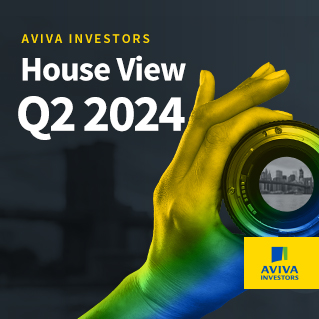The big picture
Unsettled new world: Plotting a course through extreme policy uncertainty.
The year ahead is likely to be marked by significant policy uncertainty, leading to a wide range of possible outcomes for the global economy. However, this does not imply the world is necessarily heading towards recession and that it will be a poor environment for risk assets.
Instead, the policy uncertainty implies a wide distribution of possible outcomes, both positive and negative. Elections, as the saying goes, have consequences. The return of President Trump to the White House is expected to bring with it a host of important changes across the policy spectrum: from trade, to tax and spending, regulation, immigration, and foreign policy.
Any one of these would be significant, so the combination and sequencing of all of them will no doubt prove challenging for markets to digest. Moreover, while the direction of travel is clear for each, the timing and magnitude are not: the new administration will only take over in the middle of January, and many of the promises made in campaigning have changed continually and are lacking in detail.
The likely increased use of tariffs is perhaps the best example. The threat and use of tariffs will probably create considerable uncertainty through 2025. While it remains to be seen what Washington does, countries that are impacted are likely to respond, in some cases in a conciliatory way and in others by retaliating. The Federal Reserve might also need to react. The bottom line is that uncertainty around shifting rules, as well as trade policy itself, will weigh on global growth.
However, other policy measures could be positive for growth, especially in the US. The extension of tax cuts for both individuals and US corporations should result in US growth accelerating in 2026. Regulatory changes could also play a role in increasing productivity and strengthening growth.
The positive reaction of US equities suggests markets view these policy changes as unlikely to derail the US economy. We broadly agree, although the range of possible outcomes is wide. This is even more pertinent outside the US, where policymakers will respond via trade, fiscal, and monetary policies. We expect global economic growth of three per cent in 2025 and 2026.
Chinese growth has continued to slow, despite the country’s increasing share of global trade. A more significant de-coupling from the US would undoubtedly hurt the economy – even if some of that trade could be redirected elsewhere. We expect further stimulus in early 2025, but it remains to be seen if that will revive domestic demand in the face of an ongoing property slump.
Europe is facing the dual challenge of a more difficult trading relationship with the US, alongside softening Chinese growth (and potential pressure from the US to reduce ties with China). While the broader euro zone has recovered reasonably well from the energy crisis of 2022/23, Germany has not. Industrial production remains weak, with automakers facing fierce Chinese competition and many other companies battling to keep costs down.
Policymakers will need to rise to the challenge, with some easing of fiscal rules likely in Germany following February’s election and potentially new funds to be made available from the EU for defence and other areas. France also faces political and fiscal ordeals.
In the UK, growth and inflation have both been a little better than expected in 2024; GDP has likely grown by nearly 1.0 per cent this year, 0.5 points higher than forecast at the start of the year, while inflation fell faster than expected to 2.50 per cent, from four per cent in 2023 and ten per cent the year before that. The new Labour government has raised taxes and spending – the latter by more than the former – to provide a boost to growth into 2025. But there is uncertainty around how businesses will respond to higher national insurance contributions – with both wage growth and employment likely to be negatively impacted.
As with growth, the range of possible outcomes for inflation next year is also wide, especially in the US where we would expect any tariffs to be passed through to consumer prices. Hence, we think central banks will be cautious in reacting strongly without a clear signal of a change in growth or inflation trends.
Figure 1: Aviva Investors’ growth projections
Source: Aviva Investors, Macrobond. Data as of December 31, 2024.
What this means for asset allocation
Equities
2024 was a year of strong equity returns but with dispersion across regions. Developed markets (DM) outperformed emerging markets (EM) and the US led across DM. While equity valuations look elevated, especially in the US, it is also hard to make a compelling argument for them to fall.
Meanwhile, corporate profits look set to rise at a brisk pace, especially in the US, given the resilience of the country’s economy, and the potential boost from government policy and the ongoing boom in spending on artificial intelligence.
Notwithstanding lofty valuations, US stocks seem likely to continue to outperform, as earnings become the main driver of stock prices, taking over from rising multiples (price/earnings ratios). While valuations are less stretched in European markets, stocks here will struggle to keep pace with their US peers given the prospect of weaker profits growth and the risk of global trade disruptions.
Figure 2: Asset allocation – Equities

Note: The weights in the asset allocation table only apply to a model portfolio without mandate constraints. Our House View asset allocation provides a comprehensive and forward-looking framework for discussion among the investment teams.
Source: Aviva Investors. Data as of December 31, 2024.
Government bonds
We are modestly overweight government bonds with a preference for the UK market. We believe gilts stand to benefit from deeper rate cuts in 2025 as the Bank of England responds to what we expect will be a faster fall in inflation than the market envisages.
While rates seem likely to fall in other developed nations, they may not fall as far as markets expect, especially in the US where inflation could stay stubbornly high.
Despite that, we expect yield curves will continue to steepen, in part because of a steady deterioration in many governments’ fiscal positions. The pandemic has created a precedent for more active fiscal support, irrespective of the phase of the business cycle; and president-elect Donald Trump’s policies look likely to add to this trend.
We are underweight Japan as we believe the Bank of Japan may be forced to tighten policy by more than the market envisages, given signs that inflationary pressures continue to build.
Figure 3: Asset allocation – Government bonds

Note: The weights in the asset allocation table only apply to a model portfolio without mandate constraints. Our House View asset allocation provides a comprehensive and forward-looking framework for discussion among the investment teams.
Source: Aviva Investors. Data as of December 31, 2024.
Credit
What had been a rocky year for corporate bond markets prior to August turned into a solid one, at least relative to government debt markets. The additional return (credit spread) investors demand as compensation for the higher risk of investing in corporate debt ended the year at a record low.
While that would usually signal corporate bonds offered a poor risk-reward, we are broadly neutral on credit overall, with overweight exposure to high-yield issuers offset by an underweight position in investment-grade bonds.
While credit spreads are tight, the creditworthiness of companies has improved, and should continue doing so given the prospect for continued earnings growth. That means spreads are likely to remain rangebound, making the yield pick-up from investing in high-yield bonds attractive. However, looking further ahead we would want to see more risk premium built into the market before increasing our allocation to this asset class.
Figure 4: Asset allocation – Credit

Note: The weights in the asset allocation table only apply to a model portfolio without mandate constraints. Our House View asset allocation provides a comprehensive and forward-looking framework for discussion among the investment teams.
Source: Aviva Investors. Data as of December 31, 2024.
Four key investment themes
1. The US under Trump 2.0
The timing, size, and details of the policies to be implemented are impossible to know precisely. But we expect sweeping tax cuts leading to a significant widening of the US deficit, perhaps to as much as seven per cent of GDP. While tariffs could help limit the deficit increase, they will be inflationary. And curbs to immigration could fuel inflation further as they will restrict the supply of labour, in turn limiting the economy’s growth potential.
Among other important changes from financial markets’ perspective, we are likely to see efforts to expand energy production, an increase in defence spending and deregulation of banking, cryptocurrencies, and consumer protections. As for tariffs, they are a small part of total tax revenues (Figure 5), and taxes overall will fall in the US. These are ‘pro-business’ policies, aimed at promoting investment and making US capital markets even more attractive relative to other nations and blocs.
Figure 5a: Tariffs are a tiny part of total tax revenue
Source: Aviva Investors, BEA, Macrobond. Data as of December 31, 2024.
Figure 5b: Tariffs are a tiny part of total tax revenue
Source: Aviva Investors, BEA, Macrobond. Data as of December 31, 2024.
2. Reshaping of global trade, fiscal and industrial policies
While globalisation is not reversing (Figure 6), it is fragmenting and becoming polarised. Together with the changes to global trade, it is not a stretch to say that the cooperative, rule-based order of the past 35 or so years is largely over.
During the election campaign, Trump made a raft of proposals to limit trade, especially with China. While a variety of laws will likely be utilised, the timing and implementation of policies, and the shape of any negotiations, is uncertain. But we expect to see a rapid and forceful escalation.
On the other hand, fiscal policy appears less of a constraint on many governments. State support for defence, energy, technology, and social goals is here to stay. This could act as an important counterweight to tariffs and trade uncertainty, if scaled up and implemented effectively.
Figure 6: China exports to different regions
Source: Aviva Investors, China General Administration of Customers. Data as of December 31, 2024.
3. Tech boom: Artificial Intelligence and beyond
Recent surveys of companies adopting AI offer conflicting reports as to the efficacy of AI within their workflow. The productivity-enhancing potential of AI is not just about efficiency gains, but also incentivising investment. Capital expenditure (capex) has been growing rapidly and is likely to continue doing so over the coming years.
As of 2024, capex in AI related categories has grown at well over double the pace of wider US fixed investment since the pandemic, and domestic production of computers and electronics has soared, too (Figure 7). The visibility of AI-related capex within the national accounts presents tangible evidence of the impact on overall economic growth.
Figure 7a: AI-related categories have outpaced broader capital formation...
Source: Aviva Investors, BEA, Macrobond. Data as of December 31, 2024.
Figure 7b: and production of tech goods has surged ahead of other industries
Source: Aviva Investors, Federal Reserve, Macrobond. Data as of December 31, 2024.
4. Monetary cycles become unsynchronised
Central bank policy remains topical and will surely be one determinant of financial market and economic results in 2025.
Although the volatility of inflation has declined, we still see a likelihood monetary policy will diverge from country to country by more than it has for some time, unless the global economy experiences a very large shock. Some central banks are accelerating rate cuts, others slowing them, and a few have yet to reduce rates from peak levels at all. This should create a chance for investors to unearth profitable opportunities in fixed income and currencies in terms of relative values.
Figure 8: Cumulative change in policy rates - marching to different drummers from now on
Source: Aviva Investors, Macrobond. Data as of December 31, 2024.
Read the House View

House View: 2025 Outlook
The year ahead is likely to be marked by significant policy uncertainty leading to a wide range of possible outcomes for the global economy. Find out more in our latest House View.
Never miss the latest House View
Sign-up to receive quarterly emails on our collective view of global markets.
About the House View
The Aviva Investors House View document is a comprehensive compilation of views and analysis from the major investment teams.
The document is produced quarterly by our investment professionals and is overseen by the Investment Strategy team. We hold a House View Forum biannually at which the main issues and arguments are introduced, discussed and debated. The process by which the House View is constructed is a collaborative one – everyone will be aware of the main themes and key aspects of the outlook. All team members have the right to challenge and all are encouraged to do so. The aim is to ensure that all contributors are fully aware of the thoughts of everyone else and that a broad consensus can be reached across the teams on the main aspects of the report.
The House View document serves two main purposes. First, its preparation provides a comprehensive and forward-looking framework for discussion among the investment teams. Secondly, it allows us to share our thinking and explain the reasons for our economic views and investment decisions to those whom they affect.
Not everyone will agree with all assumptions made and all of the conclusions reached. No-one can predict the future perfectly. But the contents of this report represent the best collective judgement of Aviva Investors on the current and future investment environment.
House View contributors

Michael Grady
Head of Investment Strategy and Chief Economist

David Nowakowski
Senior Strategist, Multi-asset & Macro

Joao Toniato
Head of Global Equity Strategy

Vasileios Gkionakis
Senior Economist and Strategist
Important information
THIS IS A MARKETING COMMUNICATION
Except where stated as otherwise, the source of all information is Aviva Investors Global Services Limited (AIGSL). Unless stated otherwise any views and opinions are those of Aviva Investors. They should not be viewed as indicating any guarantee of return from an investment managed by Aviva Investors nor as advice of any nature. Information contained herein has been obtained from sources believed to be reliable but, has not been independently verified by Aviva Investors and is not guaranteed to be accurate. Past performance is not a guide to the future. The value of an investment and any income from it may go down as well as up and the investor may not get back the original amount invested. Nothing in this material, including any references to specific securities, assets classes and financial markets is intended to or should be construed as advice or recommendations of any nature. Some data shown are hypothetical or projected and may not come to pass as stated due to changes in market conditions and are not guarantees of future outcomes. This material is not a recommendation to sell or purchase any investment.
The information contained herein is for general guidance only. It is the responsibility of any person or persons in possession of this information to inform themselves of, and to observe, all applicable laws and regulations of any relevant jurisdiction. The information contained herein does not constitute an offer or solicitation to any person in any jurisdiction in which such offer or solicitation is not authorised or to any person to whom it would be unlawful to make such offer or solicitation.
In Europe this document is issued by Aviva Investors Luxembourg S.A. Registered Office: 2 rue du Fort Bourbon, 1st Floor, 1249 Luxembourg. Supervised by Commission de Surveillance du Secteur Financier. An Aviva company. In the UK Issued by Aviva Investors Global Services Limited. Registered in England No. 1151805. Registered Office: 80 Fenchurch Street, London EC3M 4AE. Authorised and regulated by the Financial Conduct Authority. Firm Reference No. 119178. In Switzerland, this document is issued by Aviva Investors Schweiz GmbH.
In Singapore, this material is being circulated by way of an arrangement with Aviva Investors Asia Pte. Limited (AIAPL) for distribution to institutional investors only. Please note that AIAPL does not provide any independent research or analysis in the substance or preparation of this material. Recipients of this material are to contact AIAPL in respect of any matters arising from, or in connection with, this material. AIAPL, a company incorporated under the laws of Singapore with registration number 200813519W, holds a valid Capital Markets Services Licence to carry out fund management activities issued under the Securities and Futures Act 2001 and is an Exempt Financial Adviser for the purposes of the Financial Advisers Act 2001. Registered Office: 138 Market Street, #05-01 CapitaGreen, Singapore 048946. This advertisement or publication has not been reviewed by the Monetary Authority of Singapore.
In Canada and the United States, this material is issued by Aviva Investors Canada Inc. (“AIC”). AIC is registered with the Ontario Securities Commission as a commodity trading manager, exempt market dealer, portfolio manager and investment fund manager. AIC is also registered as an exempt market dealer and portfolio manager in each province and territory of Canada and may also be registered as an investment fund manager in certain other applicable provinces. In the United States, AIC is registered as investment adviser with the U.S. Securities and Exchange Commission, and as commodity trading adviser with the National Futures Association.
The name “Aviva Investors” as used in this material refers to the global organisation of affiliated asset management businesses operating under the Aviva Investors name. Each Aviva investors’ affiliate is a subsidiary of Aviva plc, a publicly- traded multi-national financial services company headquartered in the United Kingdom.
AIQ Investment Thinking
Get our perspective on key themes influencing investment markets globally.






